Recipe schemes for pizzeria cuisine. Fast food plus design
Take a pizzeria with orders up to a thousand a day. Multiply the number of orders by the number of pizzerias in different cities of Russia. Do not forget that often come to fast food for a side job, why you need to quickly train people and just as quickly achieve their speed in their work. This is the description of the company in which I work.
To make a pizza, an employee in the kitchen should know her recipe.

')
I was faced with the task of devising schemes, looking at which even a “man from the street”, being on the Pizza Assembly Line, would be able to assemble a pizza without errors. As a result, schemes were created to be used in different pizzerias from different cities, instructions were drawn and tests were conducted on “people from the street”. About how it was I want to tell.
To begin with, the pizzeria has been working for a couple of years when a new design of tables with recipes was needed. That is, the recipes have already been placed above the pizza assembly line.

Line to redesign
Pizza recipe schemes already existed, why make a new design?
First, the recipes themselves had to be changed in order to unify the number of ingredients in different pizzas strongly - this will increase the speed at which recipes are remembered by pizza makers. Secondly, the existing recipe layout has proven challenging for quick perception.
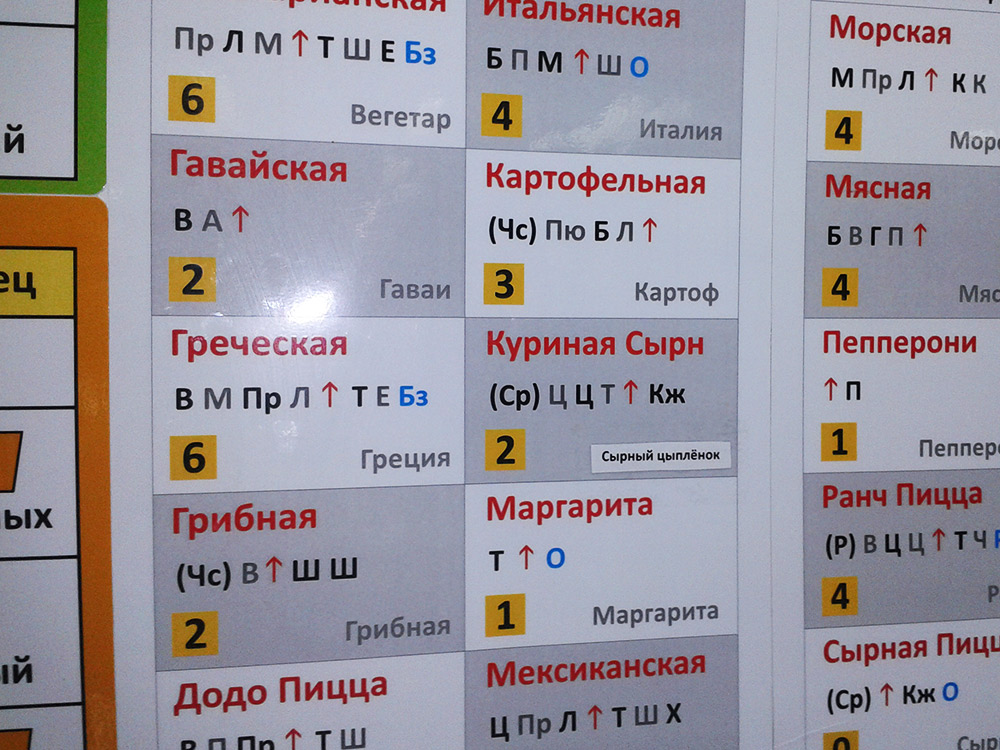
Pizza Recipes The block consists of the name of the pizza, the order of the ingredients, the sum of the ingredients in the pizza (needed to find the quantity of the ingredient in the table with the quantities) and the abbreviated name in the IC. Arrow denotes Mozzarella cheese. Double portion is shown by repetition of reduction. The alternation of black and gray colors of fonts (does not have a logical sense), the blue color of the ingredients added after the furnace.
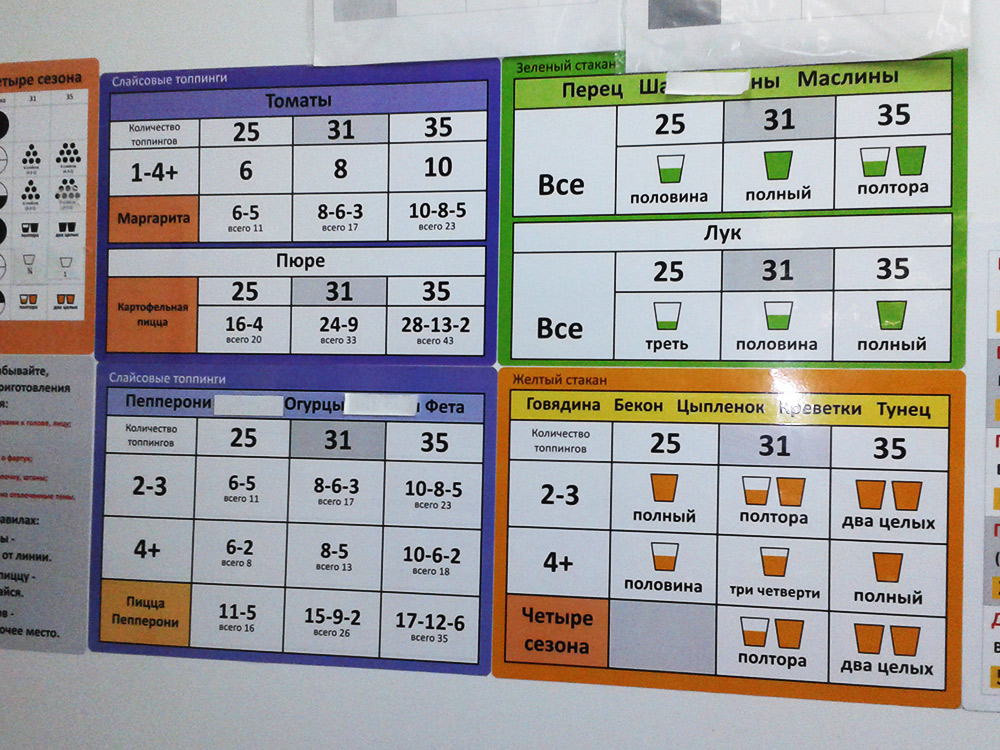
Tables with quantities of ingredients. There is a dependence on the size of the pizza and on the total number of ingredients in the pizza, but first you have to find the ingredient among all the others in the heading of the table.

Example with champignons - the quantity in recipes has changed and a separate sheet has been printed out for them on the printer, covering the name of the ingredient in the old tables
So, the essence of the task: to create a pizza recipe scheme that will be quickly read by an untrained person and that will be easy to remember .
We worked on the tables together with Evgenia Savchuk, who is responsible for recipes at the pizzeria. She already had the first ideas about future recipes products.
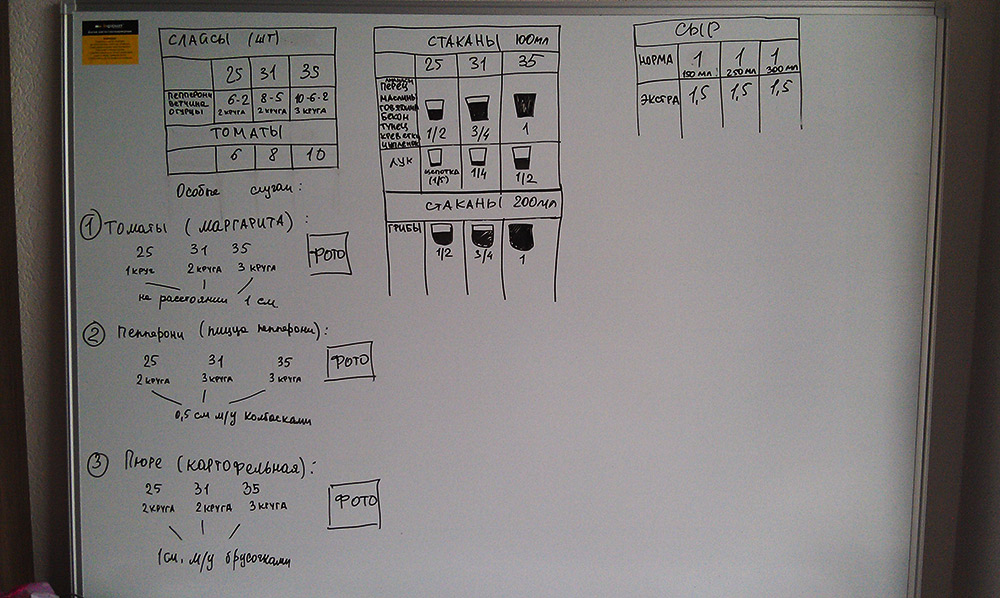
Amounts already known for most ingredients.
The most important thing is that in new recipes, the need to know the amount of ingredients in pizzas has disappeared, and the quantities of ingredients added have been averaged for all pizzas.
Soon the first sketches are born.
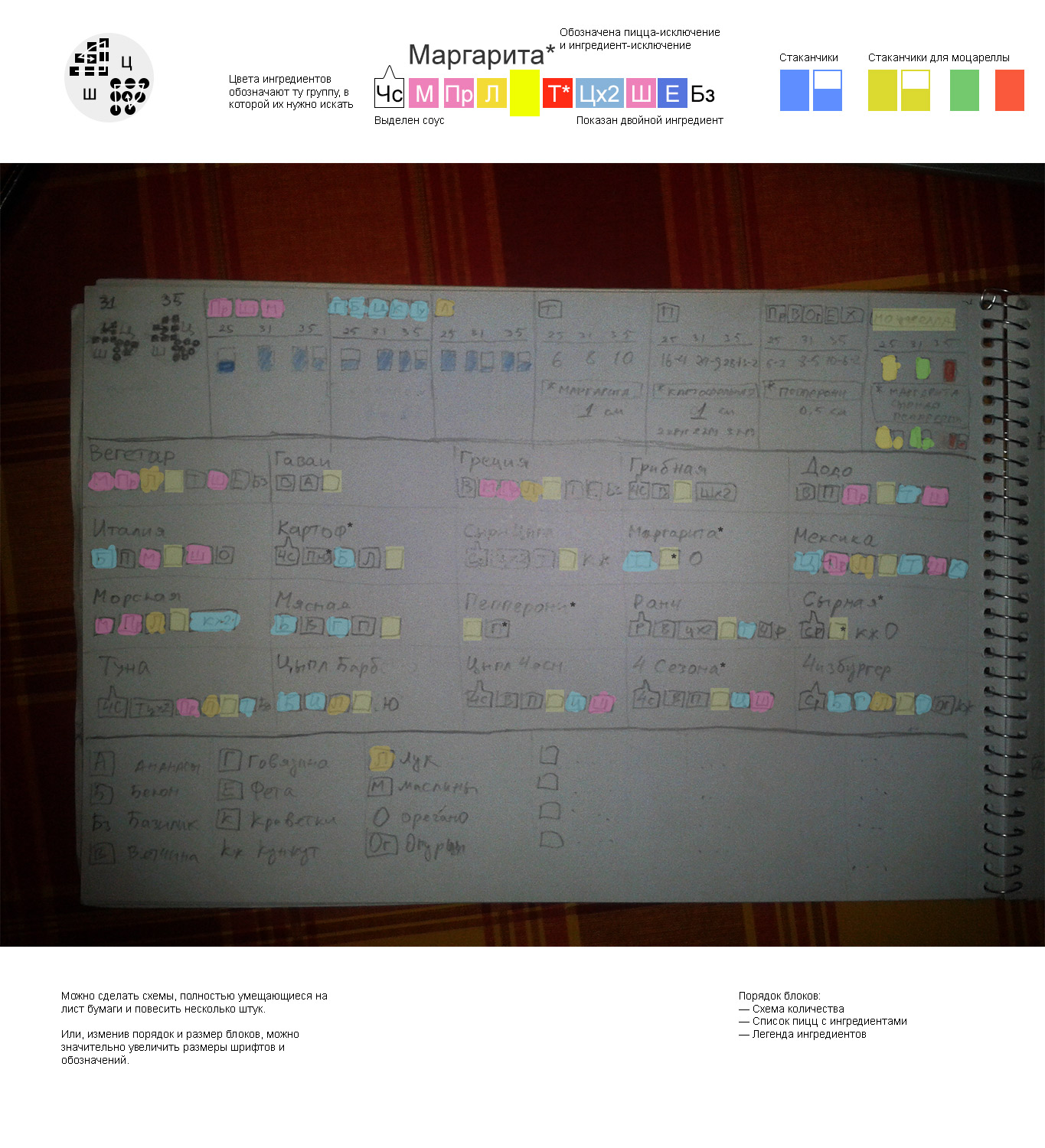
A pencil sketch on paper was photographed and processed in Photoshop. Added colors and comments
Each ingredient is placed in the cell. . Without cells, sesame-type ingredients remain that are added after the oven. The sauce is proposed to denote a separate icon
. Without cells, sesame-type ingredients remain that are added after the oven. The sauce is proposed to denote a separate icon  (most pizzas are made on pizza sauce, so it is not indicated).
(most pizzas are made on pizza sauce, so it is not indicated).
It is already obvious that not all quantities for ingredients can be unified, therefore there will be exceptions (indicated by an asterisk *).
There is a thought to get away from the icons of cups to more abstractly depict the number . The idea did not take root and the icons of the cups returned.
. The idea did not take root and the icons of the cups returned.
Based on the fact that the ingredients will be divided into groups by quantity and still being guided by the previous scheme, I propose to color the ingredients in different colors depending on the group. Immediately it becomes clear that in the recipe diagram such a number of colors will be very difficult to read.

The second approach. Here, for the first time, there appears a version with cell division into cups / slices through the background color (some ingredients are scooped up by cups, and some are laid out individually) - a dark background of the slice ingredients.

One of the sketches with explanations, sent for discussion
In the third approach I try to find alternatives.
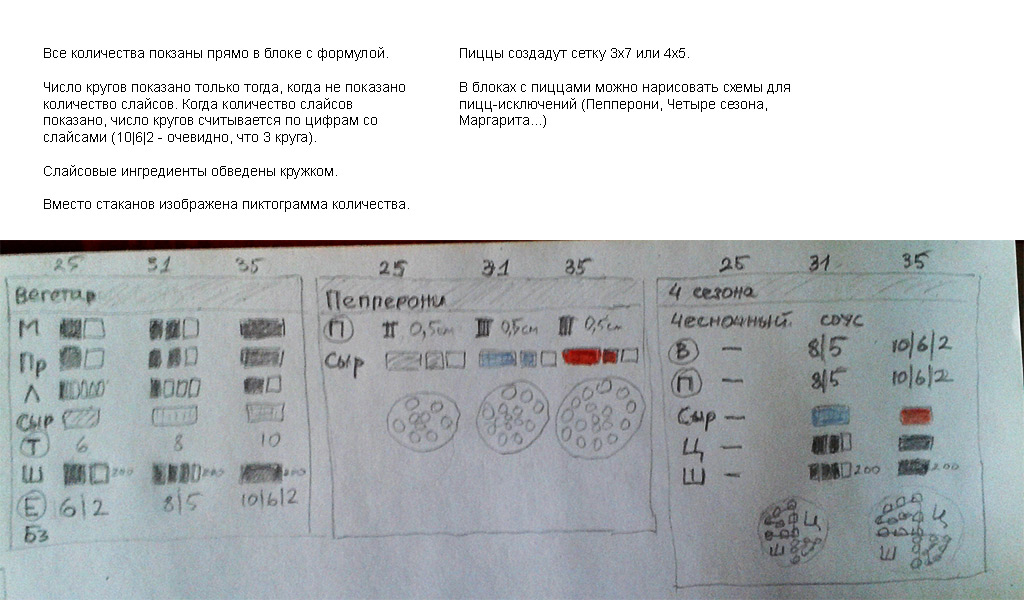
Another sketch with comments sent for discussion.
Here it is proposed to simply show the number of all the ingredients for each pizza in the pizza unit itself, that is, to combine recipes and quantity schemes. As it turned out later, Papa John's recipes are organized on just this principle. Its disadvantage is that you have to memorize a recipe for each existing pizza separately.
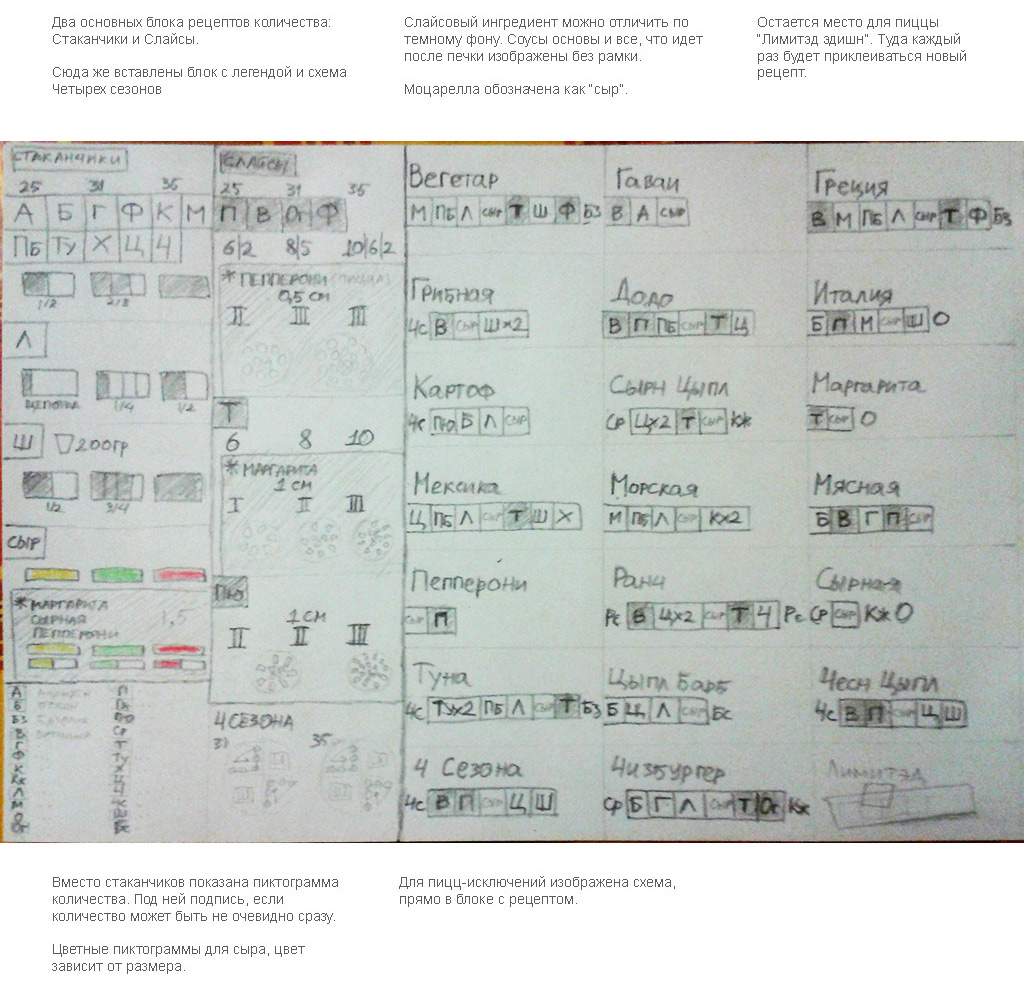
The final sketch. Most of the details and approaches used as a result are exactly those shown here.

First purebred
Here recipes and quantities fit on one printed sheet. Instead of pictogram cups, and abbreviations are decoded in a separate block in the lower left.

Detailed version of the first design with explanations
Now you need to place the diagram on the "wall". In the process there are new solutions on the format and size of the blocks.

Pizza recipes begin to separate from quantity schemes.
There were a lot of accommodation options later. Changes in placement have caused changes in the format and size of instructions.
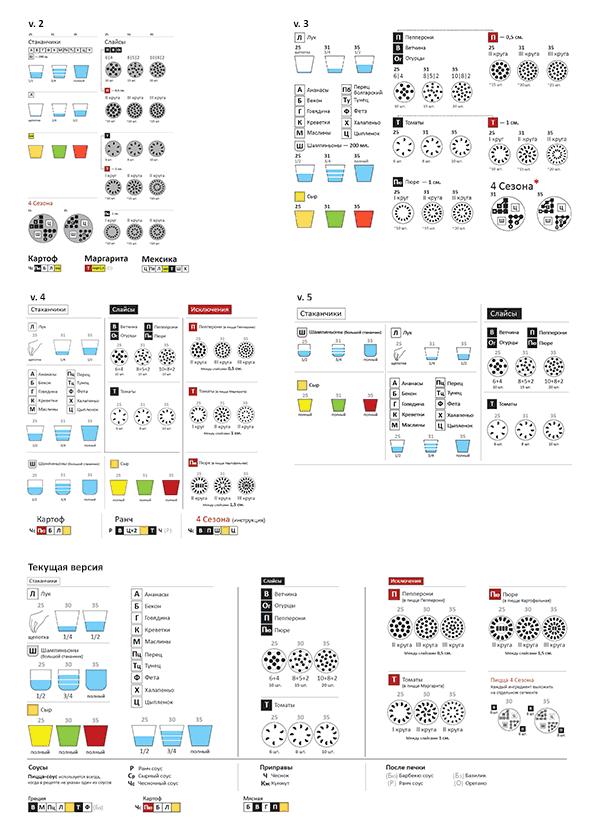
Major changes from version to version (click to enlarge)
So, the schemes came to the mind in which they are now placed in pizzerias. About why decisions were made about changes, how the process of testing versions went and how the instructions for the schemes looked in different ways - I want to tell you in the next article.
To make a pizza, an employee in the kitchen should know her recipe.

')
I was faced with the task of devising schemes, looking at which even a “man from the street”, being on the Pizza Assembly Line, would be able to assemble a pizza without errors. As a result, schemes were created to be used in different pizzerias from different cities, instructions were drawn and tests were conducted on “people from the street”. About how it was I want to tell.
To begin with, the pizzeria has been working for a couple of years when a new design of tables with recipes was needed. That is, the recipes have already been placed above the pizza assembly line.

Line to redesign
Pizza recipe schemes already existed, why make a new design?
First, the recipes themselves had to be changed in order to unify the number of ingredients in different pizzas strongly - this will increase the speed at which recipes are remembered by pizza makers. Secondly, the existing recipe layout has proven challenging for quick perception.

Pizza Recipes The block consists of the name of the pizza, the order of the ingredients, the sum of the ingredients in the pizza (needed to find the quantity of the ingredient in the table with the quantities) and the abbreviated name in the IC. Arrow denotes Mozzarella cheese. Double portion is shown by repetition of reduction. The alternation of black and gray colors of fonts (does not have a logical sense), the blue color of the ingredients added after the furnace.

Tables with quantities of ingredients. There is a dependence on the size of the pizza and on the total number of ingredients in the pizza, but first you have to find the ingredient among all the others in the heading of the table.

Example with champignons - the quantity in recipes has changed and a separate sheet has been printed out for them on the printer, covering the name of the ingredient in the old tables
So, the essence of the task: to create a pizza recipe scheme that will be quickly read by an untrained person and that will be easy to remember .
Finding a solution
We worked on the tables together with Evgenia Savchuk, who is responsible for recipes at the pizzeria. She already had the first ideas about future recipes products.

Amounts already known for most ingredients.
The most important thing is that in new recipes, the need to know the amount of ingredients in pizzas has disappeared, and the quantities of ingredients added have been averaged for all pizzas.
Soon the first sketches are born.

A pencil sketch on paper was photographed and processed in Photoshop. Added colors and comments
Each ingredient is placed in the cell.
 . Without cells, sesame-type ingredients remain that are added after the oven. The sauce is proposed to denote a separate icon
. Without cells, sesame-type ingredients remain that are added after the oven. The sauce is proposed to denote a separate icon  (most pizzas are made on pizza sauce, so it is not indicated).
(most pizzas are made on pizza sauce, so it is not indicated).It is already obvious that not all quantities for ingredients can be unified, therefore there will be exceptions (indicated by an asterisk *).
There is a thought to get away from the icons of cups to more abstractly depict the number
 . The idea did not take root and the icons of the cups returned.
. The idea did not take root and the icons of the cups returned.Based on the fact that the ingredients will be divided into groups by quantity and still being guided by the previous scheme, I propose to color the ingredients in different colors depending on the group. Immediately it becomes clear that in the recipe diagram such a number of colors will be very difficult to read.

The second approach. Here, for the first time, there appears a version with cell division into cups / slices through the background color (some ingredients are scooped up by cups, and some are laid out individually) - a dark background of the slice ingredients.

One of the sketches with explanations, sent for discussion
In the third approach I try to find alternatives.

Another sketch with comments sent for discussion.
Here it is proposed to simply show the number of all the ingredients for each pizza in the pizza unit itself, that is, to combine recipes and quantity schemes. As it turned out later, Papa John's recipes are organized on just this principle. Its disadvantage is that you have to memorize a recipe for each existing pizza separately.

The final sketch. Most of the details and approaches used as a result are exactly those shown here.
Solution refinement

First purebred
Here recipes and quantities fit on one printed sheet. Instead of pictogram cups, and abbreviations are decoded in a separate block in the lower left.

Detailed version of the first design with explanations
Now you need to place the diagram on the "wall". In the process there are new solutions on the format and size of the blocks.

Pizza recipes begin to separate from quantity schemes.
There were a lot of accommodation options later. Changes in placement have caused changes in the format and size of instructions.

Major changes from version to version (click to enlarge)
So, the schemes came to the mind in which they are now placed in pizzerias. About why decisions were made about changes, how the process of testing versions went and how the instructions for the schemes looked in different ways - I want to tell you in the next article.
Source: https://habr.com/ru/post/194834/
All Articles